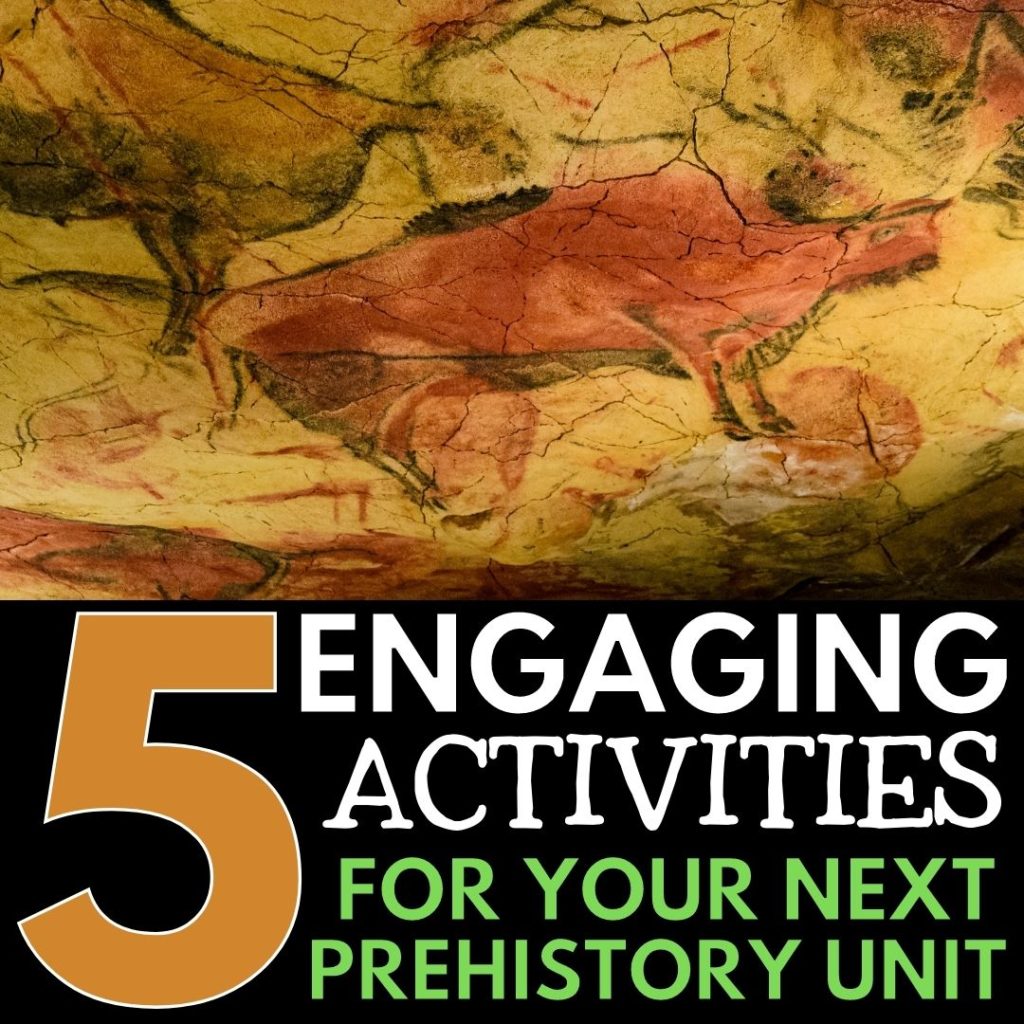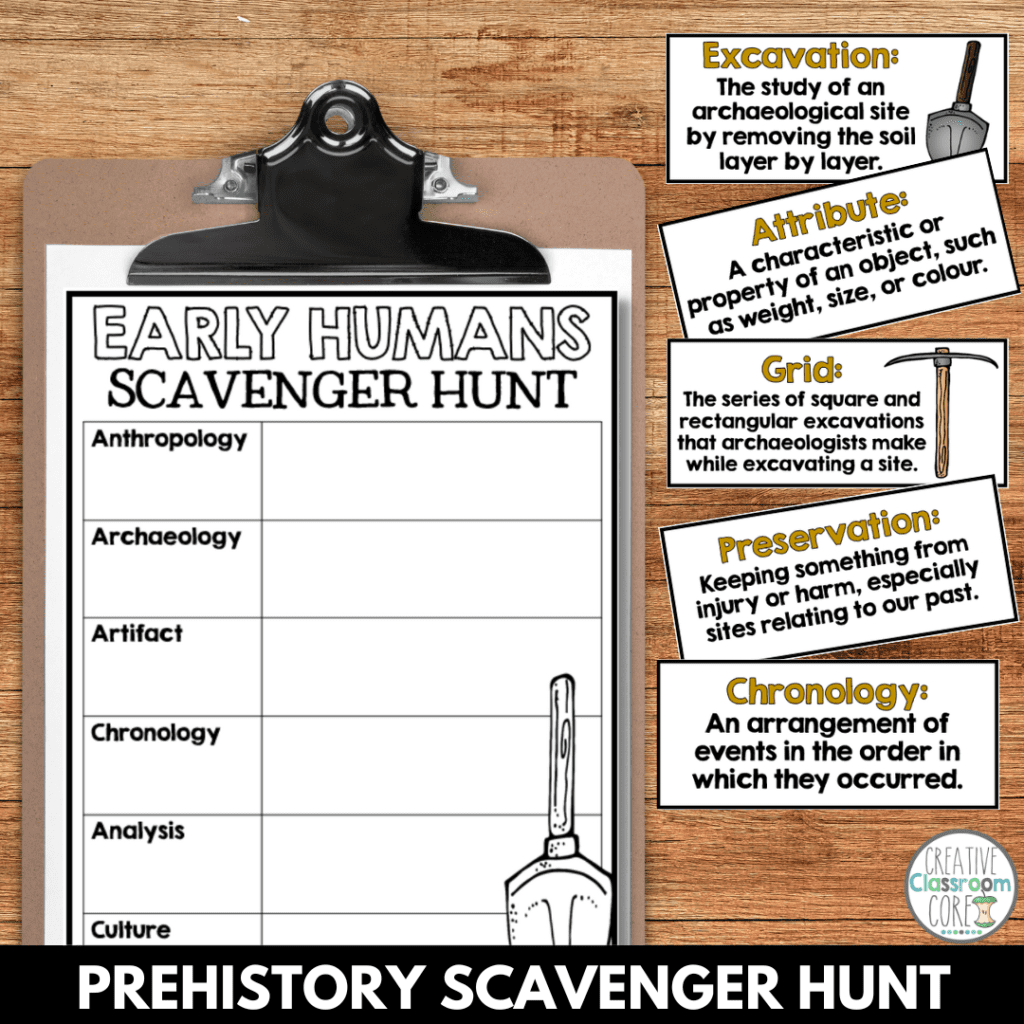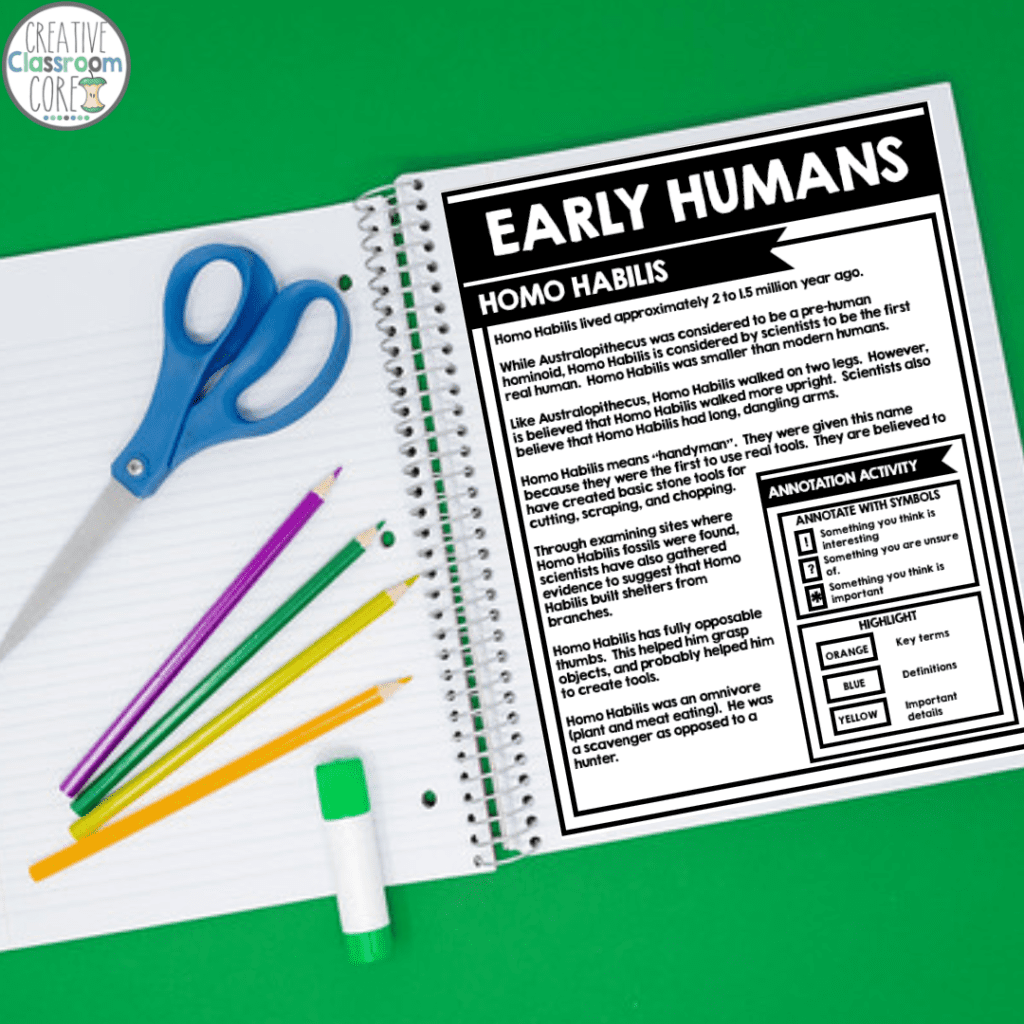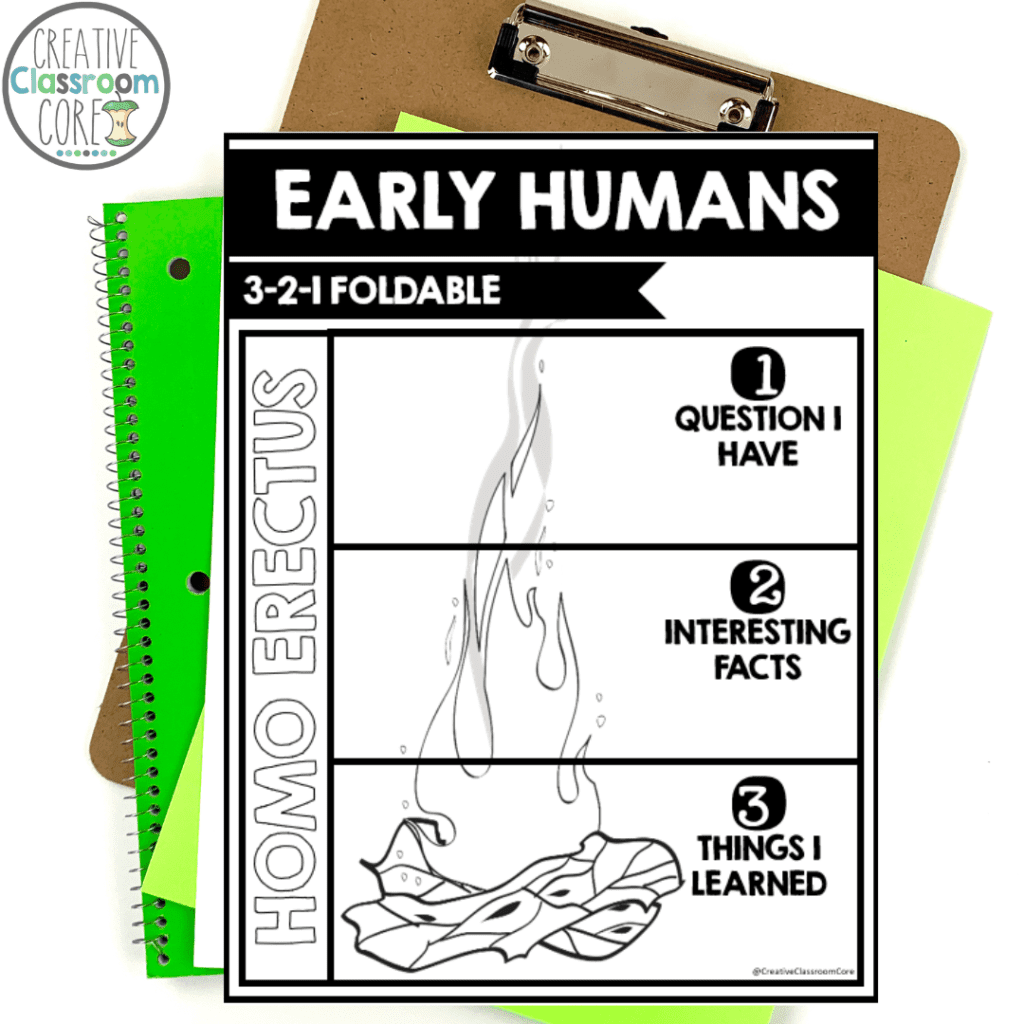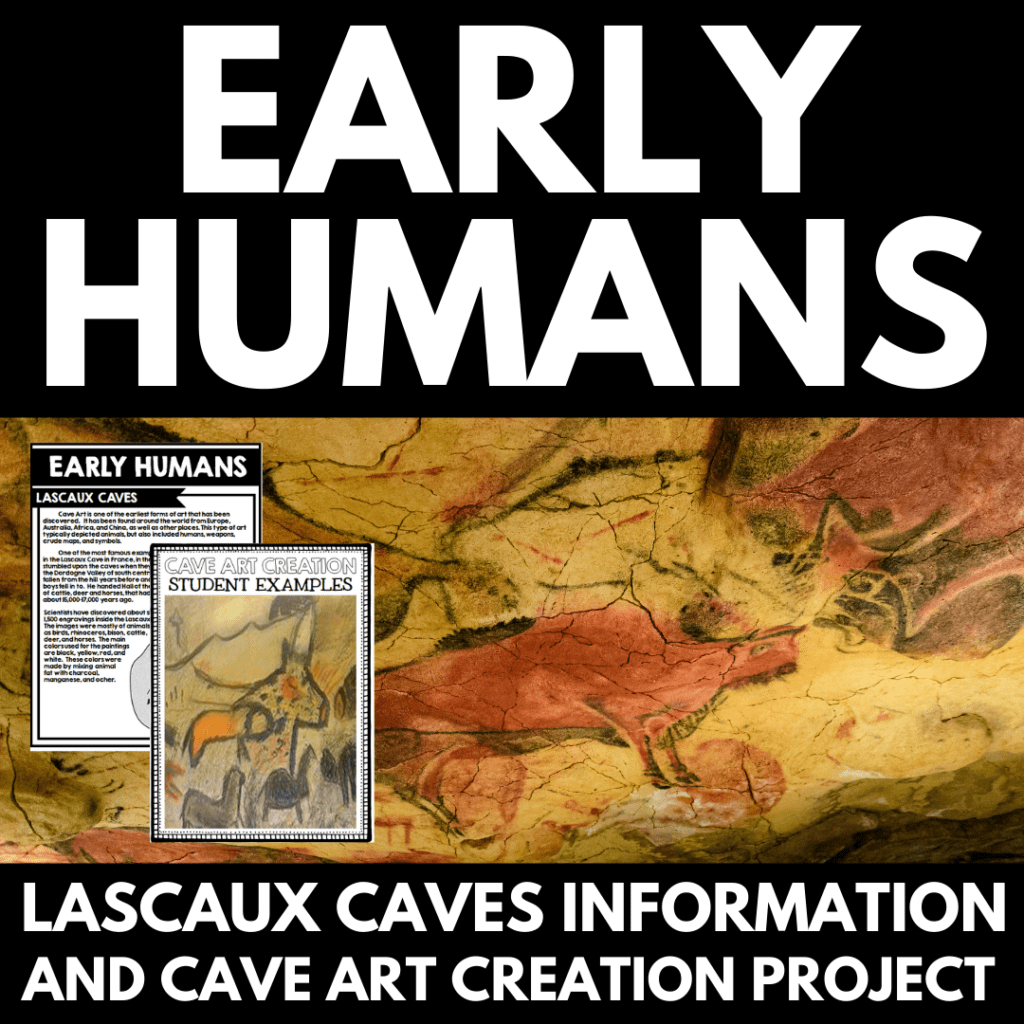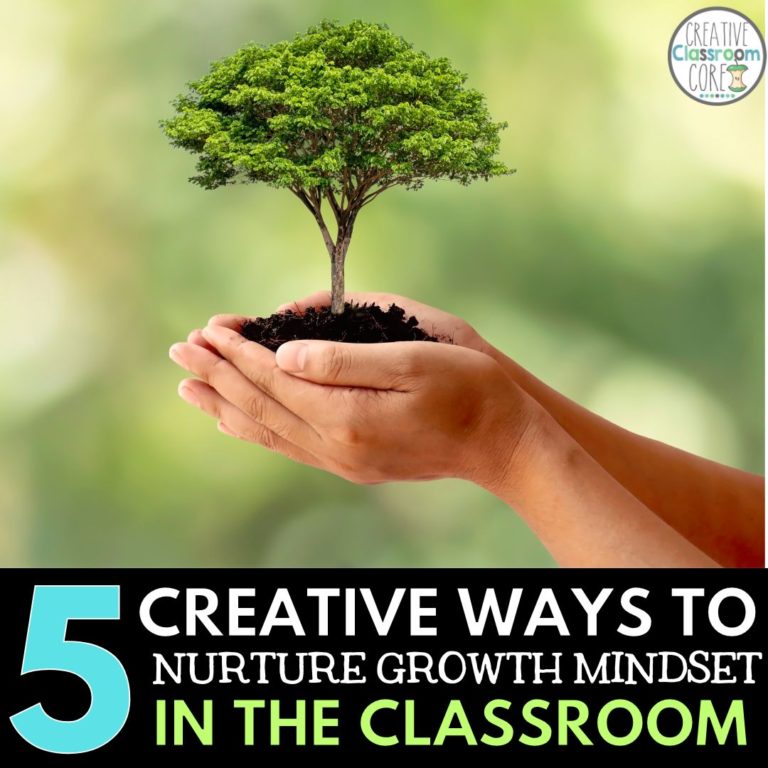Prehistory Unit for Middle School – 5 engaging Activities
By MARISSA DESPINS Updated April 04, 2024
Prehistory is the period of human history between the first use of stone tools and the beginning of recorded history when writing systems were invented. A Prehistory Unit can be incredibly engaging to teach, as it covers the development of early humans, fascinating cave paintings, and the development of the first true civilizations. With so much great content, your Prehistory Unit does not have to be boring!
Looking for some ready to teach resources for your next prehistory unit? Click on the link or button below to see all of the prehistory resources available in my TPT shop!
To help spice things up a bit, and make your planning a little bit easier, I have included 5 super easy, no-prep activities to help bring your next Prehistory Unit to life!
*** Make sure you read through to the bottom and snag yourself this fun Early Humans FREEBIE!
Prehistory Unit Vocabulary Scavenger Hunt
Scavenger hunts are some of my very favorite ways to introduce new vocabulary in my social studies classroom. And, in a prehistory unit, there is a lot of new vocabulary for students to learn. Working through a scavenger hunt activity makes the idea of learning so many new terms seem a lot less daunting and a lot more fun.
First, cut out and laminate the vocabulary cards. You will need these for the activity, but can also save them to use later in a classroom word wall. Next, tape the words around your classroom, hallway, or outdoor space.
Finally, pass students a clipboard and term sheet, and have them “hunt” around for the vocabulary words. This activity is much more fun that sitting in a desk and copying down word after word. Instead, it gets kids up, moving, and interacting. Sounds like a win for me!
Feeling a little “extra”? Borrow a sand table and digging tool from the kindergarten classroom. Burry the words in the sand, and have small groups take turns “excavating” the terms. I can say from personal experience that middle school kiddos get incredibly excited about having the opportunity to play in the sandbox again! Just be sure to place a tarp underneath – things can get a little messy!
Grab this activity to use with your learners here.
Text Annotation Activities to Build understanding
Spending time reading passive chapters of boring text is a sure fire way to make students hate studying history. Instead, I much prefer providing my students with smaller chunks of text that they can annotate with their own thoughts, responses, and questions.
Close reading is a super effective strategy to help students understand complex text. Repeated readings and annotation deepens student understanding and allows students to make real life connections to what they are reading. Close reading asks students to slow down and focus deeply on a text.
To build understanding, I have students annotate small chunks of text on each of the topics focused on in our Prehistory Unit. Using different colored markers, students highlight and respond to the text. I have built an annotation guide directly into the reading passages, to make things even easier.
Once completed, I have students share their annotations with a partner. I encourage them to add to their own responses during these conversations. The annotated passages make excellent interactive notebook additions, as students can flip back to them to clarify understanding or review as needed.
Snag a copy of this activity to use in your own classroom by clicking here.
For more information on text annotation, check out our tips and tricks for close reading guide.
Interactive Foldable Activities
Followers of the blog already know how much I love using interactive foldables with my learners. To sum up some of the benefits that I have talked about in the past:
- Engagement – interactive activities that flip, flap, and fold are so much more fun than traditional style worksheets.
- Application – instead of mindlessly answering comprehension questions, foldable activities ask students to take information they have learned and actually apply it in creative ways.
- Organization – foldable activities are designed to help organize complex information, making it easier for students to grasp new concepts.
- Review – completed activities make phenomenal review tools that students can refer back to as needed.
As there is so much new content in a Prehistory Unit, foldable activities work great to organize student thinking. This activity is a favorite of mine, as it asks students to choose and record three key facts they have learned. To do this, students must think through and summarize information in order to determine importance. Doing this requires students to practice key reading comprehension strategies!
Pick up a copy of these activities in my TPT store by clicking here.
For additional information on foldable activities and interactive notebooks, check out our Interactive Notebook Guide and Top Tips for Interactive Notebook Success!
Classroom Cave Painting
Looking for an activity to really breath life into your Prehistory curriculum? Painting our own “Classroom Cave”, early human-style, has been a classroom favorite since I first started teaching about Ancient Civilizations. I can say with all honesty that it is likely the activity my students most look forward to and talk about.
Start by showing students images from the Lascaux Caves. A simple google search will bring up a lot of different images. Alternately, you can show students the video (or other similar videos on YouTube) below.
Discuss the images with the class – you may want to ask the following questions:
·Why were these images created?
·What different animals can you see?
·Why do you think Early Humans chose each different material to create these images?
·What colors/techniques were used?
·What things do you think Early Humans valued?
Next, have students sketch sample images from what they have viewed on the provided handout. Giving students the opportunity to plan out their ideas first will lead to a better final product.
Finally, cover a large section of the wall with crumpled butcher paper. After students have decided on an image and completed their drafts, have them use their natural paintbrushes and black ink to sketch their images. Have students shade with charcoal and earth tone chalk pastels.
For a complete unit featuring this activity, with student examples, teaching tips, and planning pages, click here or on the image below.
For additional information on the benefits of integrating art based activities into your history curriculum, check out our arts integration guide!
Early Human Mini Books
As a final project for the unit, I have students create foldable accordion books that discuss everything they have learned about the different early humans. In order to complete the activity, students must refer back to the different activities they have completed throughout the unit, making it a great review activity.
To construct their books, students cut out the templates, glue them side by side along a long strip of paper, and fold the spaces between each template accordion style. Alternately, they can staple them together like a regular book.
On each page, students write about and illustrate important information they have learned. I like to encourage students to make super detailed images, including key facts about each type of early humans. For example, they may want to include an image of the tools used by homo habilis. This will help them make mental pictures, helping with information recall come test time! When complete, they make great interactive notebook additions or hallway displays!
Grab a copy of this final Prehistory project to use with your learners by clicking here.
I hope you are able to find some fun activities here to add to your Prehistory curriculum. Do you have some fun activities to share? Send me a message on Instagram – I would love to hear all about them!
Looking for more information on teaching about Ancient History? Check out our top tips for engaging history lessons and detailed guide on the importance of teaching about Ancient History.
Looking for a complete Prehistory unit?
All of the activities mentioned in this post can be found in my COMPLETE Early Humans Unit. It contains 90 pages of print and digital resource, with reading passages, comprehension questions, foldable activities, and fun projects. You can grab the unit for your own classroom by clicking here or on the image below!
Looking for a fun Freebie to use with your Prehistory Unit?
Check out these FREE word wall cards! They contain 26 different word wall cards, each featuring a key vocabulary word, definition, and historical image.
You can grab yourself a copy of these cards for FREE by clicking here or on the image below.
Interested in learning more about teaching ancient civilizations?
Check out my previous posts below!
7 Essential Topics for teaching about Ancient Egypt
9 Essential Topics for your next Ancient Greece Unit
Trojan War Activities for Middle School
Interactive Notebook Activities for Greek Mythology
Interactive Notebook Activities for Ancient Egypt
Interested in signing up for my email list?
If you are interested in signing up for my email list, you can do so by clicking on the link below. I periodically send out emails with free resources, teaching tips, and exclusive deals. Signing up will also give you immediate access to some of my best selling Interactive Notebook resources – foldables, graphic organizers, and other fun activities.
